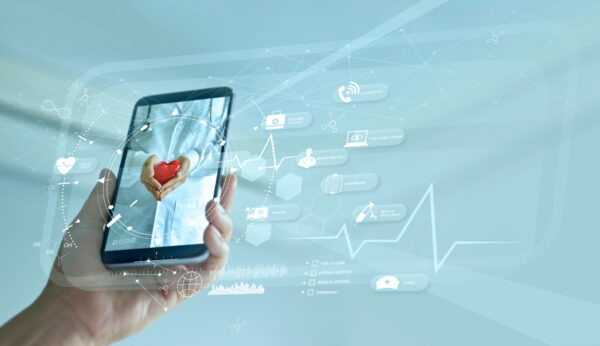
While social media offers benefits, there are ample indicators that, coupled with smartphones, it poses a risk of harm to the mental health and well-being of children and adolescents. As a neurologist and neuroscientist, I have growing concerns regarding the effects of social media and smartphone use on brain health. And yet, there is ample evidence that when properly used, the technology leveraged in social media and smartphones has the capability to provide immense health benefits.
This past May, the Advisory on Social Media and Youth Mental Health was issued by the US Surgeon General; he said, “We are in the middle of a national youth mental health crisis, and I am concerned that social media is an important driver of that crisis – one that we must urgently address.” That position is echoed in social psychologist Jonathan Haidt’s “The Anxious Generation”, published earlier this year, which lays blame for the crisis on unfettered teen use of social media and smartphones.
The concern stems from the fact that at the time smartphones were widely adopted, teenage mental illness rates turned sharply upward and have been rising ever since. Among U.S. college students, depression and anxiety more than doubled between 2010 and 2018. Emergency room visits for self-harm rose by 188% between 2010 and 2020 for teenage girls and 48% for boys in the U.S., while the suicide rate for younger adolescents also increased, by 167% among girls and 91% among boys. Similar trends have been observed in other high-income countries.

As Healthcare and Biopharma Companies Embrace AI, Insurance Underwriters See Risks and Opportunities
In an interview, Munich Re Specialty Senior Vice President Jim Craig talked about the risk that accompanies innovation and the important role that insurers play.
Numerous studies and clinical observations suggest that excessive or compulsive engagement with these technologies can induce significant structural and functional changes in the brain. When we use our smartphones, our neuroplasticity – the brain’s ability to reorganize and form new connections in response to experiences and learning – is accessed. The result is very rapid behavioral change due to a process that might be called “rewiring the brain,” in which neural pathways are re-routed and solidified to support and reward certain actions.
Among the key regions affected by the combination of smartphones and social media is the prefrontal cortex, responsible for executive function, decision-making, and impulse control. In addition, because social media platforms are designed to capture user attention through reward circuits that release dopamine and lead to addictive behaviors, the nucleus accumbens, central to the brain’s reward circuitry and addiction, is also impacted, resulting in compulsive use, addictive behaviors and the suppression of inhibitory brain regions responsible for prioritizing tasks.
The dopamine-driven reward system undoubtedly contributes to the addictive qualities of social media and mobile apps. However, it is essential to recognize that the problem extends beyond mere addiction. The constant exposure to curated highlight reels, social comparison, and cyberbullying can create a toxic environment that profoundly affects young people’s self-esteem, body image, and overall mental health.
This exposure affects several different parts of the brain which are vulnerable to the impacts of smartphones and social media. The insula, related to self-awareness and empathy, shows altered activity which can affect self-image and social cognition, leading to reduced social integration. The anterior cingulate cortex, which plays a role in emotional stability and regulation and impulse control, is also impacted, potentially triggering mood disorders.

NEMT Partner Guide: Why Payers and Providers Should Choose MediDrive’s TMS
Alan Murray on improving access for medical transportation.
While excessive social media use can lead to these negative changes, targeted interventions and healthier technology habits can promote neuroplasticity to achieve positive ends. We are now just scratching the surface of what can be achieved by clinicians and software engineers working together, using digital rewiring to provide beneficial treatments for a wide range of disorders and conditions.
Prescription digital therapeutics (PDTs) are FDA-regulated, app-based treatments that are prescribed by a physician and created with the highest degree of clinical rigor with efficacy and safety in mind. When patients engage with their smartphones, these interactive app-based therapies prompt them to take action through audio, visual, and haptic cues. These actions are designed to engage the brain and re-route neural pathways, making patients’ next action stronger, and their responses faster and more robust. The result is the creation of new neural responses and the establishment of beneficial habits that lead to, for example, improved pain management or reduction of migraine attacks.
With PDTs, clinicians are seeing immediate effects; in our collective clinical experience, psychological and exposure interventions have taken months, years, and sometimes decades to show results. But with smartphone apps that leverage neuroplasticity, we are seeing the timeline to achieving beneficial changes in the brain compressed to just a few weeks.
Much of the mechanism of PDTs have their roots in cognitive behavioral therapy (CBT), which capitalizes on gamification principles to treat psychological challenges. But PDTs can take this a step further, retraining the brain with targeted neuromodulation exercises in app-based treatments, teaching it to function differently in real-world settings by building skills and positive behaviors. Much like the muscle training exercises that take place in physical therapy and occupational therapy, the “muscles” or connections in your brain need to be strengthened before meaningful use in everyday life. In these ways, PDTs provide therapeutic benefits with minimal side effects, making it possible to treat almost any condition you can envision, from migraine to multiple sclerosis to obesity.
With PDTs, physicians are also offering a new kind of treatment plan that involves both pharmaceutical-based medication and a prescription digital therapeutic. Accessible through a smartphone, the digital therapeutic delivers personalized, evidence-based interventions to a patient’s condition, completed through daily lessons and game-like interfaces, all guided by sophisticated algorithms. Medication and digital therapeutics can also work together as software-enhanced drugs to deliver the best possible outcomes, an approach that is becoming established through clinical evidence and supported by practice guidelines recently issued by the FDA that chart a path to a new standard of care.
Smartphones present a public health challenge, but they also provide a powerful health care opportunity. Addressing difficult-to-treat diseases and disorders, quickly, safely, and with little to no side effects through PDTs is a positive boon to our overburdened health system. PDTs provide great advancements on behalf of patients. It is up to America’s innovators and policymakers to recognize the health benefits, put measures in place to guard against risks, and to make the right decisions that will best support the patients who most need help.
Photo: ipopba, Getty Images
Dr. Shaheen Lakhan, MD, PhD, FAAN, is an inventive physician-scientist, esteemed biopharma board director, and distinguished biotech executive with 20 years of experience in healthcare, academia, and industry. He is board-certified in both neurology and pain medicine trained at Cleveland Clinic and Massachusetts General Hospital. Passionate about the convergence of science, technology, and medicine, he pioneered several novel therapeutics and clinical service lines to benefit patients in need. He serves as Chief Medical Officer at Click Therapeutics.
This post appears through the MedCity Influencers program. Anyone can publish their perspective on business and innovation in healthcare on MedCity News through MedCity Influencers. Click here to find out how.







